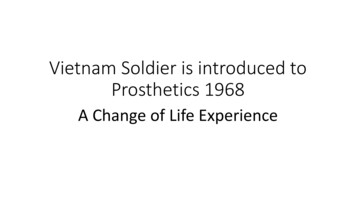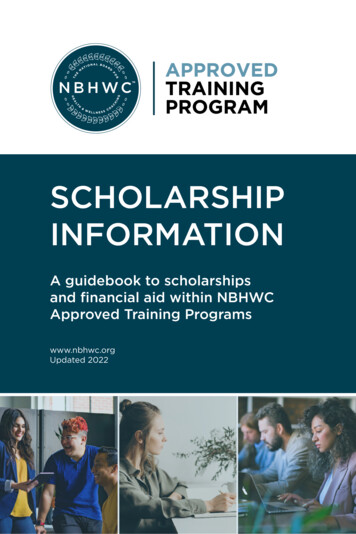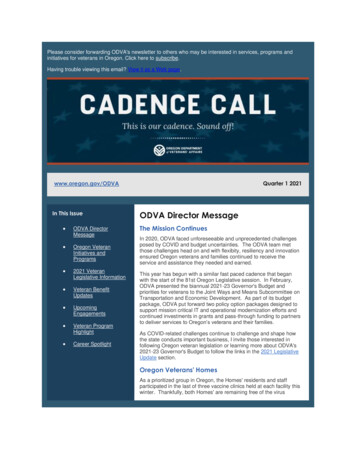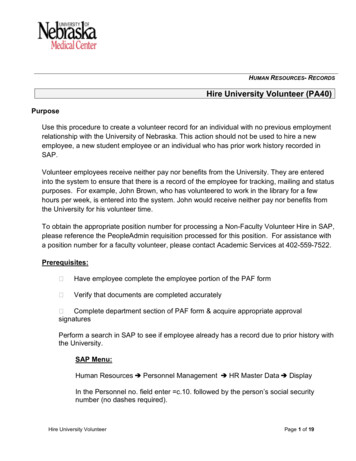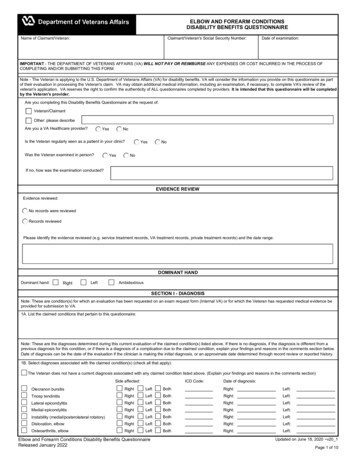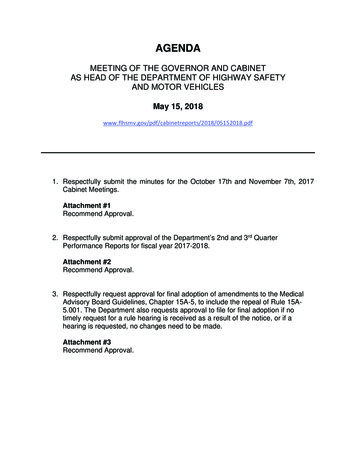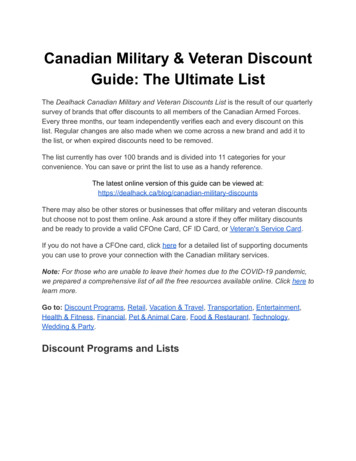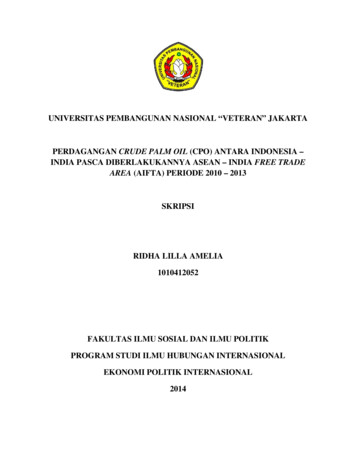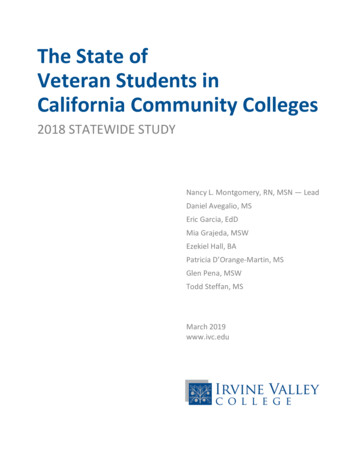
Transcription
The State ofVeteran Students inCalifornia Community Colleges2018 STATEWIDE STUDYNancy L. Montgomery, RN, MSN — LeadDaniel Avegalio, MSEric Garcia, EdDMia Grajeda, MSWEzekiel Hall, BAPatricia D’Orange-Martin, MSGlen Pena, MSWTodd Steffan, MSMarch 2019www.ivc.edu
AcknowledgementsThe Research and Planning Group for California Community Colleges (RP Group) would like toexpress its gratitude to Nancy Montgomery, Assistant Dean of Health, Wellness, and VeteransServices at Irvine Valley College, whose dedication to the academic success of both theCalifornia Community College Veteran student population and the centers that support thesestudents was the impetus for this project.We would also like to recognize the participation by the California Community Colleges (CCC)who provided their time and resources, in terms of staff and students, in order for us to obtainthe data and information needed to conduct this study.Lastly, we would like to thank the Veteran students themselves for sharing their experiences soopenly with us.The Research Team from RP Group who analyzed the data and wrote the report include thefollowing dedicated members:Project TeamTim NguyenIreri ValenzuelaAndrew KretzAlyssa NguyenEditorsDarla CooperPriyadarshini Chaplotwww.rpgroup.orgThe State of Veteran Students in California Community Colleges: 2018 Statewide StudyRP Group March 2019 Page 2
Table of ContentsAcknowledgements2Table of Contents3Executive Summary6Background6Findings and Recommendations6Concluding Remarks9Introduction10Military Transition Theory10Veterans Transitioning into Higher Education11Reader’s Guide14Study Methodology14Study Findings15Veteran Students in California Community Colleges15Veteran Student Characteristics15Military Service16Health18Health Coverage18Service Connected Disability18Health Issues20Education Profile22Veterans Affairs Education Assistance22First-Generation Status and Highest Degree Attained23Current Grade Point Average (GPA)24The Current State of CCC Veteran Resource Centers24VRC Size and Staffing24VRC Resources and Supports25Veteran Students’ Educational Experiences27Transitioning from Military to Civilian life27Structure to Little StructureThe State of Veteran Students in California Community Colleges: 2018 Statewide StudyRP Group March 2019 Page 328
Learning to Navigate the VA and the Community College Systems28Veterans Resource Center Staff Help with Navigation29Being a Veteran Student30Struggles to Balance Responsibilities30Financial Struggles31Benefits are like Paychecks32Interactions with the College as a Whole32Campus Climate34VRC Staff Advocate for Veterans36Interactions with Faculty36Politics in the Classroom37Veterans Resource Centers38Veteran Resource Centers as “Safe” Spaces39Experiences with VRC Counselors and Staff39Mental Health Counseling41Evening Hours Needed42Services and Resources42Physical Space43Discussion of Findings and Recommendations44Key Finding #1: Unmet mental health needs44Recommendation 1.144Recommendation 1.245Key Finding #2: Lack of understanding of Veteran students’ unique challenges among nonVRC staff and faculty45Recommendation 2.145Recommendation 2.245Key Finding #3: Need for student-friendly business hours and spaces45Recommendation 3.145Recommendation 3.246Key Finding #4: Need for increased capacity to support Veteran students’ education planningand benefits46Recommendation 4.1The State of Veteran Students in California Community Colleges: 2018 Statewide StudyRP Group March 2019 Page 446
Recommendation 4.246Recommendation 4.346Key Finding #5: Need for stronger partnerships between the VA and VRCs to support Veteranstudents’ transition46Recommendation 5.1Key Finding #6: Lack of consistent and reliable data about Veteran studentsRecommendation 6.1Concluding Remarks47474747Appendix A: Best Practices and Important Considerations49Appendix B: List of Colleges from 2018 Site Visits51Appendix C: Colleges from Student Veteran Surveys52Appendix D: Position Descriptions54Veterans Affairs Certifying Official54Veterans Counselor55VA Vocational Rehabilitation (Vet Success on Campus [VSOC]) Counselors55The State of Veteran Students in California Community Colleges: 2018 Statewide StudyRP Group March 2019 Page 5
Executive SummaryBackgroundThis report provides a snapshot of the state of the Veteran Resource Centers in the CaliforniaCommunity College system, and of the Veteran student population and their unique academicexperiences in that system. In July 2018, the California Community Colleges Chancellor’s Office(CCCCO) awarded a 2M innovation grant to Irvine Valley College (IVC) to enhance the successof student Veteran programs throughout the state of California based on the successesexperienced from the college’s Objective Rally Point 2 Veterans Resource Centers (ORP2VRC).The goal of this grant is to develop trainings for California Community College staff who supportVeteran students, and develop a “best practices” toolkit that will assist these staff inimplementing, enhancing, and/or maintaining comprehensive student supports that aretypically centralized at each college’s Veterans Resource Center (VRC). To inform this work,Nancy Montgomery, Assistant Dean of Health, Wellness, and Veterans Services at Irvine ValleyCollege, coordinated a team of community college Veteran services representatives along withresearchers from the Research and Planning Group for California Community Colleges (RPGroup) to collect data on VRCs and Veteran students throughout the state.The Military Transition Theory provides a framework for understanding the multiple factorsthat can impact a veteran’s transition back to civilian life. The theory’s components have beenadapted to evaluate Veteran students’ transition to the education system as a way to helpinform efforts to improve their educational experience in the California Community College(CCC) system. A mixed-methods evaluation model was used to collect data and information toprovide a snapshot of VRCs in CCC. These methods include: a student survey, student focusgroups, VRC staff interviews, and observations at the VRCs.Findings and RecommendationsFindings from the aforementioned activities revealed the following six key themes and servedas a foundation for a set of recommendations, both which can inform IVC’s efforts to advocatefor and develop a best-practices toolkit and resources tailored to enhancing, developing,implementing, and maintaining a comprehensive Veteran student-centered program.Key Finding #1: Unmet mental health needsBased on staff interviews and experiences shared by students, it appears that most mentalhealth services accessed by veterans are provided through community partners, and manyVRCs throughout the state do not have any dedicated mental health services on campus.The State of Veteran Students in California Community Colleges: 2018 Statewide StudyRP Group March 2019 Page 6
Recommendation 1.1Identify ways for colleges to provide more on-site mental health services. Possible optionsinclude community partnerships where the mental health specialist comes to the college,partnering with psychology programs at four-year universities that could place interns at thecollege with supervision, or support groups in the form of group counseling with a trainedprofessional.Recommendation 1.2Study VRCs that have effectively implemented mental health services and disseminate thesefindings as effective practices to help inform VRCs throughout the state.Key Finding #2: Lack of understanding of Veteran students’ unique challengesamong non-VRC staff and facultyFocus group participants shared mixed experiences with faculty, staff, and students specificallyciting a lack of sensitivity to the disabilities of Veteran students, the triggers Veteran studentsmay experience in the classroom, and a lack of flexibility and willingness to work with Veteranstudents’ schedules.Recommendation 2.1Identify college-wide professional development/training opportunities to help administrators,faculty, staff, and students understand the unique culture and experiences of Veteran studentsand develop the skills to respond to the specific needs of Veteran students that affect theirability to successfully reach their educational goals.Recommendation 2.2Provide resources and information to faculty that can be embedded in their course syllabi as away to raise awareness among faculty and students about the needs of the Veteran students,and as a way to raise awareness with Veteran students about the resources/supports availableto them.Key Finding #3: Need for student-friendly business hours and spacesVeteran students noted that more often than not, VRCs are not open in the evening andtherefore not serving Veteran students who work full-time and/or take evening courses. Inaddition, both VRC staff and students noted that some of the VRC spaces are not large enoughto provide very many services for students.The State of Veteran Students in California Community Colleges: 2018 Statewide StudyRP Group March 2019 Page 7
Recommendation 3.1Provide VRCs with resources and information for how to analyze Veteran student enrollmenttrends in order to identify the most optimal business hours that best align with their students’schedules that can include extending hours into the evening, or even weekend options.Recommendation 3.2Study VRCs that have maximized the use of their spaces based on resources and supports anddisseminate effective practices to help inform VRCs throughout the state.Key Finding #4: Need for increased capacity to support Veteran students’educational planning and benefitsThe two biggest challenges cited by students in the VRCs was the lack of available counselingappointments when they need to complete their education plans and lack of trained counselorswho could effectively help them navigate the VA benefit system.Recommendation 4.1Identify training opportunities for college staff and counselors to emphasize the need for 100%accuracy between students’ education plan on file at the college and VA certificationsubmission.Recommendation 4.2Develop a checklist protocol that lists common VA education plan certification errors (seeAppendix A: Best Practices and Important Considerations) that counselors and Veteran studentscan go through together during their appointment to ensure that the VA education plansubmission is as accurate and complete as possible.Recommendation 4.3Examine how technology can improve and streamline Veteran students’ education planningneeds.Key Finding #5: Need for stronger partnerships between the VA and VRCs tosupport Veteran students’ transitionThere appears to be missed opportunities to strengthen partnerships to support a smoothertransition from the military to education between the Department of Veterans Affairs andVRCs. As noted, VRCs play an important role in helping veterans learn how to navigate thepolicies and procedures of community colleges as well as the additional requirements placed onthem when accessing VA benefits.The State of Veteran Students in California Community Colleges: 2018 Statewide StudyRP Group March 2019 Page 8
Recommendation 5.1Advocate for stronger partnerships between the VRCs and VA offices across the state tocoordinate and co-identify practices and processes to streamline the onboarding process forprospective and current Veteran students to ensure successful transition from the military tothe educational setting.Key Finding #6: Lack of consistent and reliable data about Veteran studentsThe lack of consistent and reliable data on Veteran students is a nationwide issue. Having anaccurate count of veterans, active duty military personnel, and military beneficiaries on acollege campus is fundamental to providing support for these students.Recommendation 6.1Advocate for data-sharing agreements to be made between the California Community CollegesChancellor’s Office and the United States Departments of Veterans Affairs and/or Defense tohave Veteran students identified more systematically, rather than relying on students’ selfreporting or using proxies such as whether a Veteran student utilizes VA education benefits.Concluding RemarksAs noted, it is not always easy for veterans to transition back to civilian life or into highereducation after their service in the military. Veterans’ physical and mental health concerns canimpede their success in college particularly when these problems intensify challenges alreadyfaced by non-Veteran students: financial barriers, housing, transportation, familyresponsibilities, work, time management, study skills, learning to navigate college policies andprocedures, and connecting with college culture. However, more often than not, communitycollege administrators, staff, faculty, and non-Veteran students may not be aware of the impacthaving served in the military can have on the ability of Veteran students to cope with andovercome many of the challenges mentioned above. In spite of these challenges, only a third ofthe Veteran students who responded to the survey had thought about dropping out of college.Despite this resiliency, VRCs and colleges can do more to support Veteran students with theirtransition from the military to an academic life. As the entire CCC system explores using theGuided Pathways framework to redesign the comprehensive student experience, this veryframework may serve as a useful model for transitioning Veteran students to and from collegesuccessfully. A focus on new student intake and a structured onboarding process, along withcontinuous assessment of personal, educational, and career needs could help Veteran studentsduring their transition to college life, connect them with other support services on campus, andlead to the successful achievement of their goals.The State of Veteran Students in California Community Colleges: 2018 Statewide StudyRP Group March 2019 Page 9
IntroductionMany US Veterans separate from the military and encounter difficulties in transitioning tocivilian life. Military separation represents significant shifts in personal and social identity,purpose, culture, relationships, and living situations in the lives of veterans. Research studiesconducted by the USC School of Social Work Center for Innovation and Research on Veterans &Military Families (CIR) 1 have found that many service members separate from the military illequipped to begin their civilian lives by not securing housing and/or employment. Additionally,service members may be contending with physical and/or mental health issues, and theseissues may be compounded by Veterans need to adjust their self-identity and transition tocivilian culture.Military Transition TheoryMilitary Transition Theory 2 (Figure 1 on the next page) postulates that there is an interactionand overlap among three components that impact successful transition from military to civilianlife: 1) the interplay between the service member’s personal characteristics along with theirmilitary cultural experiences, and how they exited the military; 2) service members’ adjustmentstyles and support systems (e.g., social, military, community, civilian); and 3) outcomesassociated with transition that include work, family, health, general wellbeing, and community.1USC School of Social Work Center for Innovation and Research on Veterans & Military Families (CIR):http://cir.usc.edu/publications2 Castro, C.A., Kintzle, S., and Hassan, A. (2015). The State of the American Veteran: The Orange County VeteransStudy. Retrieved from: eterans-Study USC-CIR Feb2015.pdfThe State of Veteran Students in California Community Colleges: 2018 Statewide StudyRP Group March 2019 Page 10
Figure 1. Military Transition Theory (MTT) from The State of the AmericanVeteran: The Orange County Veterans StudyVeterans Transitioning into Higher EducationMilitary Transition Theory (MTT) provides a useful framework for understanding the variousfactors that affect a successful transition to civilian life, and is applicable to different subgroupsof transitioning veterans. This study adapts that framework to an educational setting. Table 1on page 11provides a crosswalk mapping the components of both the MTT and the study as away to assess veterans’ successful transition from military to postsecondary life. As moreVeterans separate from the military and enroll in higher education, colleges and universitiescan utilize this framework to further understand and develop programs to better serve theirVeteran student populations.The State of Veteran Students in California Community Colleges: 2018 Statewide StudyRP Group March 2019 Page 11
Table 1. Crosswalk of MTT Components and Study’s ComponentsMTT ComponentStudy ComponentsApproaching the MilitaryTransitionVeteran students’ self-reported demographics, military history, andreported physical and mental health.Managing the TransitionVeteran students’ self-reported information on their support networksand military transition management, including Veterans Affairsbenefits. Veteran student support from the student and collegeperspectives.Assessing the TransitionVeteran students’ reported college experience.According to the US Department of Veterans Affairs, there are 1.7 million veterans living inCalifornia 3 and close to 94,000 veterans and their beneficiaries receiving education benefits tofurther their education in the state. In the 2017-2018 academic year, California CommunityColleges (CCC) enrolled 2.1 million students, of which 54,368 (annual unduplicated headcount)students were currently on active duty, a veteran, or a member of the Active Guard Reserve orNational Guard.4Historically and continuing to present day, California Community Colleges have had difficultiesidentifying their Veteran student population, and measuring their progress in completing acertificate or degree, and/or transferring to a four-year university. While knowing Veteranstudent completion of these academic milestones is important, colleges can be better informedby more immediate data on their Veteran students in order for college staff can assist thesestudents before they stop out or drop out of college.To address this issue, the Veterans Resource Center (VRC) at Irvine Valley College (IVC) begancollecting additional data on its students by developing a student intake form (see Appendix A).The information gathered through the intake form is used by VRC staff to ensure they areproviding the appropriate services required by their students. Furthermore, the college alsomonitors its students’ progress along specific program pathways.In 2014, after IVC opened its VRC, college staff conducted a needs assessment to examinepotential barriers students were facing in their educational journeys. College staff were3Summary data for California during the 2016-2017 fiscal year were extracted on 2/1/2019 from the USDepartment of Veterans Affairs website: fornia-fy20174 The estimated 54,368 annual unduplicated headcount (2017-2018) for Veteran students attending CaliforniaCommunity Colleges is a new calculation that was published by the California Community Colleges Chancellor’sOffice on the Student Success Metrics on 1/31/2019. These estimates are new, and work continues to refine thesefigures. A detailed discussion on Veteran student data is provided in the California Community Colleges VeteranStudent Data section of this report.The State of Veteran Students in California Community Colleges: 2018 Statewide StudyRP Group March 2019 Page 12
concerned with what they uncovered. Almost half of their Veteran students screened positivefor post-traumatic stress disorder (PTSD), 40.5% expressed concerns about depression, and36.5% indicated they had anxiety. Additionally, IVC Veteran students needed more remediationin math and English coursework than non-Veteran students, lacked personal support systems,had limited financial resources, and exhausted much of their GI Bill education benefits due tohigh unit accumulation.5In order to better serve their Veteran students, IVC implemented the Objective Rally Point 2Veterans Resource Center (ORP2VRC) framework in fall 2015 which emphasizes a holisticstudent-centered approach. Following the Guided Pathways model, ORP2VRC incorporates bestpractices along Veteran students’ academic pathways that include: New student intake processContinuous assessment of personal, educational, and career needsStructured onboarding processAccelerated remediationIntervention resources and trackingIndividualized program maps and transfer pathwaysProactive academic and career advisingMilestone nudges based on course and/or unit completionVeterans-trained psychologist (hired with grant funds)As a result of Irvine Valley College’s ORP2VRC program, the college saw improvements in itsstudents’ outcomes. There have been increases in the number of visits to its VRC, transfer-levelmath completion, certificate and degrees attainment, transfer to universities, and a decrease inexcess unit accumulation. In addition, IVC observed decreased issues of suicide ideation,depression, and PTSD amongst its Veteran students. IVC’s work to improve the success of itsVeteran students was recognized by the Chancellor’s Office, the Foundation for CaliforniaCommunity Colleges, and the Legislature when it was awarded the 2M Chancellor’s HigherEducation Innovation Award grant. With this grant award, IVC plans to develop a toolkit andprofessional development program to train other colleges on the practices that have beeneffective for IVC Veteran students. To inform this work, Nancy Montgomery, Assistant Dean ofHealth, Wellness, and Veterans at Irvine Valley College (IVC), coordinated a team of communitycollege Veterans services representatives along with researchers from the Research andPlanning Group for California Community Colleges (RP Group) to collect data on VRCs andVeteran students throughout the state.5Information from the Irvine Valley College’s Innovation Grant Award applicationThe State of Veteran Students in California Community Colleges: 2018 Statewide StudyRP Group March 2019 Page 13
Reader’s GuideThis report begins by describing some of the issues many veterans face after they separatefrom the military as they transition to their civilian lives. A framework for understanding thistransition process, Military Transition Theory (MTT) 6 is described to outline the multiple factorsthat can impact a veteran’s transition. This study adapts the MTT components to evaluateVeteran students’ transition in the California Community Colleges. Next, the researchmethodology for this study is described, followed by the Study Findings section. The StudyFindings section is divided into three parts: the state of Veteran students, the state of CCCVeteran Resource Centers in CCC, and the educational experiences of Veteran studentsattending California Community Colleges. Finally, key findings are discussed andrecommendations are proposed.Study MethodologyIn order to examine the state of Veteran Resource Centers and the experience of Veteranstudents across the California Community College system, a mixed-methods research designwas employed. The data collection methods used for this study are listed below, along withbrief descriptions of the types of data collected.1. Veterans Resource Center Documented Observations: Between October 2018 andFebruary 2019, a team of eight California Community College Veterans servicesprofessionals conducted site-visits to 106 California community colleges (see Appendix Bfor list of colleges). An observation protocol was utilized to note characteristics for eachVRC such as square footage, office and counseling spaces, types of services provided,and resources such as computers and printing. Observation protocols were onlycompleted and reported for 99 colleges.2. IVC’s 2017 Survey of CCC Veteran Resource Centers: IVC collected similar data to theaforementioned observation protocol through e-mail inquiries of VRCs and phoneinterviews (N 75) (See Appendix C for list of colleges).3. Veteran Student Survey: Between October 2018 and January 2019, online and papersurveys were administered to Veteran students across 75 California community colleges(N 1,365). Survey information collected included student characteristics, militarybackground, and students’ access, usage, and experiences with services at the VRC andthe college.4. Veteran Student Focus Groups: Between November 2018 and January 2019, fivestudent focus groups were conducted at five California Community College campuses innorthern, central, and southern California. An RP Group researcher facilitated thesesessions based on a consistent focus group protocol that asked Veteran students theservices and resources currently used on campus, unmet needs, and their overall6Castro, C.A., Kintzle, S., and Hassan, A. (2015). The State of the American Veteran: The Orange County VeteransStudy. Retrieved from: eterans-Study USC-CIR Feb2015.pdfThe State of Veteran Students in California Community Colleges: 2018 Statewide StudyRP Group March 2019 Page 14
educational experiences at each of their respective colleges. A total of 23 Veteranstudents participated in focus groups sessions.5. Veteran Service Staff Interviews: At the same colleges where the student focus groupswere conducted, staff at the Veterans services centers were also interviewed by the RPGroup researcher. These staff hold job titles such as Certifying Official, VRCDirector/Coordinator, Veterans Counselor, and Program Specialist. A consistentinterview protocol asked these staff about their perceptions of the Veteran students’experiences, challenges, resources, and continuing needs. Seven Veterans servicesprofessionals participated in these interviews.Study FindingsThe study findings are divided into three parts: (1) who are the Veteran students in CCC, (2) thestate of Veteran Resource Centers in CCC, and (3) the educational experiences of Veteranstudents attending California Community Colleges.Veteran Students in California Community CollegesResults from the Veteran student survey inform the following snapshot of Veteran studentsattending California Community Colleges. This section provides more details about: Veteranstudents’ characteristics such as age, gender, employment and living arrangements;involvement in the military; health information; and educational background.Veteran Student CharacteristicsFigure 2 on page 16provides a snapshot of the characteristics of Veteran students and theirmilitary service background based on the completed surveys of 1,365 students across 75 CCC. 7The overwhelming majority of survey respondents are male (81%), and overall Veteranstudents are between the ages of 21 to 40 years of age, with 34 being the average. Moreover,60% respondents indicated being either single, divorced, or separated and the majority ofVeteran students reported living with family (58%). Lastly, when asked about their employmentstatus, 46% of survey respondents indicated they were unemployed, 34% reported workingpart-time, and 20% worked full-time.While survey results are detailed in this section, it is difficult to determine how representative these 1,365students are to the population of all Veteran students in California Community Colleges due to the lack ofdisaggregated Veteran student information. The National Association of Student Personnel Administrators (NASPA)published a research summary that highlighted the issue of higher education institutions not having consistent andreliable approaches to identify military-connected individuals on their campuses ary.pdf). Data from theChancellor’s Office and the Department of Veterans Affairs, show roughly 34,000 (unduplicated) veterans wereenrolled and received VA education benefits in fall 2017 and with 1,365 Veteran students completing the survey,the survey response rate would be approximately 4%.7The State of Veteran Students in California Community Colleges: 2018 Statewide StudyRP Group March 2019 Page 15
Military ServiceThe military is made up of five branches: Air Force, Army, Coast Guard, Marine Corps, and Navy.When people in the military talk about their “military” status, they will typically refer tothemselves as: being on active duty, being in a reserve and/or guard forces, or being a veteran. 8The overwhelming majority (91%) of students identified as veterans, and 9% identified as activereservists/military or members of the National Guard. Furthermore, a little over two-thirds(68%) of these students served in either the U.S. Army or U.S. Marine Corps. When Veteranstudents were asked how long they had served in the military, 80% reported serving eight orfewer years, and 9% served between nine and 12 years. Lastly, 61% of Veteran studentsindicated having served in a combat zone or having been deployed /us-military-overview.htmlThe State of Veteran Students in California Community Colleges: 2018 Statewide StudyRP Group March 2019 Page 16
Figure 2. Snapshot of CCC Veteran StudentsThe State of Veteran Students in California Community Colleges: 2018 Statewide StudyRP Group March 2019 Page 17
HealthMany veterans separate from the military with physical and mental health issues. This sectionprovides information on Veteran students’ self-reported health coverage, disability, andphysical and mental health issues.HEALTH COVERAGENearly 60% of Veteran students who responded to the survey indicated receiving eitherVeterans Benefits Administration or VA Health Care services. Over 90% of surveyed studentsreported having some form of healthcare—although almost 10% indicated having no he
College, coordinated a team of community college Veteran services representatives along with researchers from the Research and Planning Group for California Community Colleges (RP Group) to collect data on VRCs and Veteran students throughout the state. The Military Transition Theory provides a framework for understanding the multiple factors



